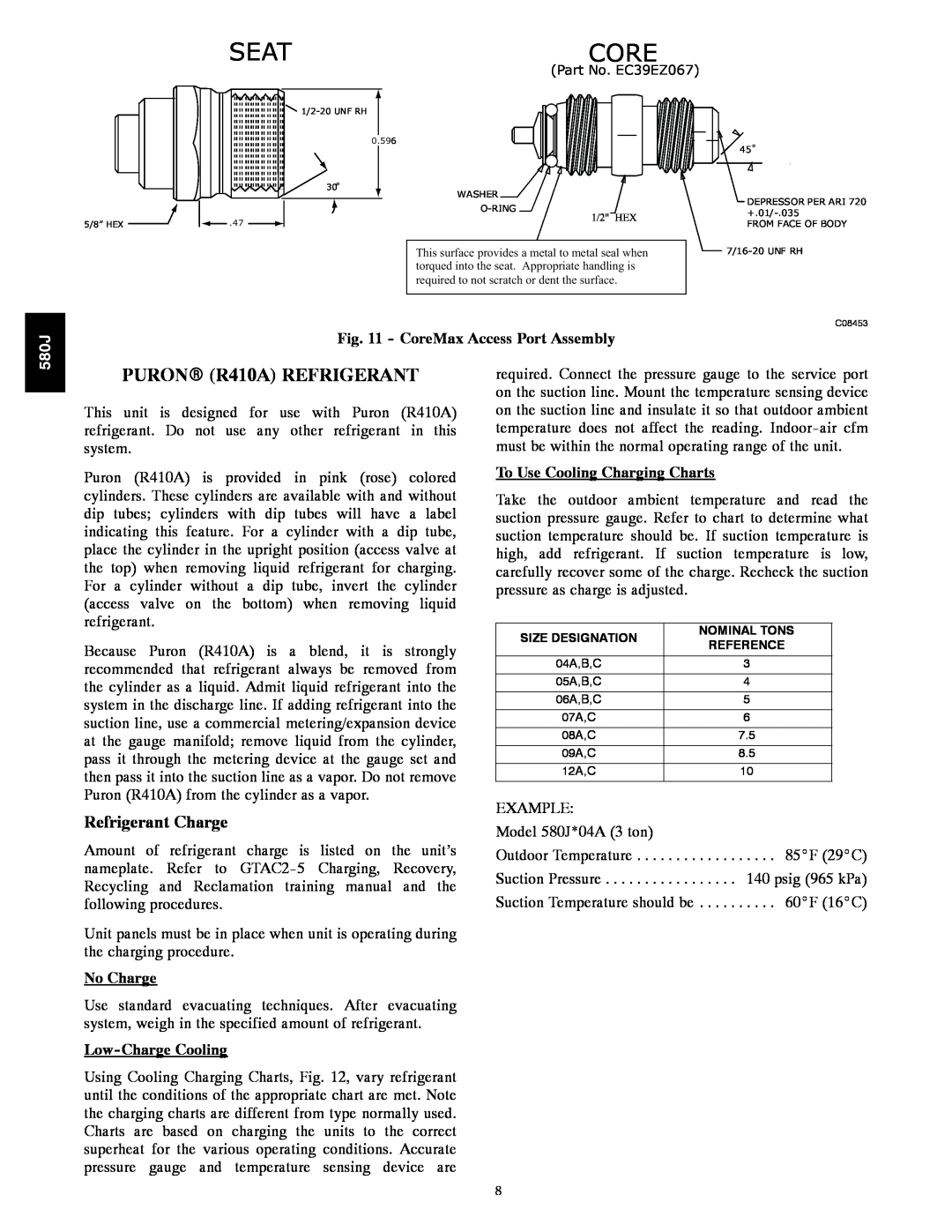TABLE OF CONTENTS
SAFETY CONSIDERATIONS
FIRE, EXPLOSION HAZARD
What to do if you smell gas
UNIT ARRANGEMENT AND ACCESS
Routine Maintenance
Seasonal Maintenance
UNIT OPERATION AND SAFETY HAZARD
Fig. 3 - Filter Installation
Fig. 4 - Screens Installed on Outdoor-AirHood
Heating
Economizer or Outside Air Damper
Adjustable-PitchPulley on Motor
SUPPLY FAN BLOWER SECTION
Supply Fan Belt-Drive
ELECTRICAL SHOCK HAZARD
Fig. 6 - Supply-FanPulley Adjustment Bearings
COOLING
Condenser Coil
Fig. 7 - Tightening Locking Collar Motor
Periodic Clean Water Rinse
Routine Cleaning of Coil Surfaces
Fig. 8 - Cleaning Condenser Coil
One-RowCoil
Refrigerant System Pressure Access Ports
Cleaning the Evaporator Coil
Evaporator Coil
UNIT DAMAGE HAZARD
Fig. 11 - CoreMax Access Port Assembly
To Use Cooling Charging Charts
PURONR R410A REFRIGERANT
Refrigerant Charge
COOLING CHARGING CHARTS
Fig. 12 - Cooling Charging Charts
580J
C08203 C08204
COOLING CHARGING CHARTS cont
Fig. 12 - Cooling Charging Charts cont
580J
C08228 C08229
COOLING CHARGING CHARTS cont
Fig. 12 - Cooling Charging Charts cont
580J
C08437 C08438
COOLING CHARGING CHARTS cont
Fig. 12 - Cooling Charging Charts cont
580J
C08439
Troubleshooting Cooling System
Fig. 13 - Condenser Fan Adjustment
Compressor
Filter Drier
Table 1 – Cooling Service Analysis
580J
Fig. 15 - Powered Convenience Outlet Wiring
CONVENIENCE OUTLETS
Fig. 14 - Convenience Outlet Location
ELECTRICAL OPERATION HAZARD
Fig. 16 - Controller Assembly
SMOKE DETECTORS
System
Sensor
Smoke Detector Locations
Location
Fig. 19 - Typical Return Air Detector Location
Fig. 20 - Return Air Sampling Tube Location
FIOP Smoke Detector Wiring and Response
Fig. 23 - Typical Smoke Detector System Wiring
Fig. 22 - Return Air Sensor Operating Position
B C D A
Sensor Alarm Test
Controller Alarm Test
Sensor Alarm Test Procedure
Controller Alarm Test Procedure
Remote Test/Reset Station Dirty Sensor Test
Detector Cleaning
To Configure the Dirty Sensor Test Operation
SD-TRK4Remote Alarm Test Procedure
Indicators
Table 3 – Detector Indicators
Alarm State
Fig. 25 - Sensor Cleaning Diagram
Troubleshooting
Resetting Alarm and Trouble Condition Trips
Sensor’s Power LED is Off
Controller’s Power LED is Off
Fig. 28 - Limit Switch Location
GAS HEATING SYSTEM
Control Circuit,
Fuel Types and Pressures
Fig. 29 - LP Low Pressure Switch Installed
Flue Gas Passageways
Combustion-AirBlower
Table 7 – Liquid Propane Manifold Pressure Ranges
Fig. 31 - Heat Exchanger Assembly
Removal and Replacement of Gas Train
Cleaning and Adjustment
Burners and Igniters
Limit Switch
Burner Ignition
Fig. 34 - Unit Control Box/IGC Location
580J
Fig. 35 - Spark Adjustment,
Fig. 36 - Spark Adjustment,
580J
C06154
Orifice Replacement
Table 8 – LED Error Code Description
Fig. 37 - Gas Valves
Single Stage
Fig. 38 - Integrated Gas Control IGC Board
Table 9 – IGC Connections
Red LED-Status
580J
Table 10 – Orifice Sizes
580J
Troubleshooting Heating System
Minimum heating entering air temperature
Table 11 cont. - Altitude Compensation* A08-A12
580J
Table 13 – Heating Service Analysis
PROBLEM
580J
CAUSE
Table 14 – IGC Board LED Alarm Codes
ECONOMIZER SYSTEMS
Fig. 39 - EconoMi$er IV Component Locations
580J
Fig. 41 - EconoMi$er IV Wiring
Fig. 40 - EconoMi$er2 Component Locations
580J
C06022
Table 15 – EconoMi$er IV Input/Output Logic
580J
Outdoor Air Temperature OAT Sensor
Supply Air Temperature SAT Sensor
EconoMi$er
Fig. 43 - EconoMi$er IV Functional View
Fig. 46 - Outside Air Temperature Changeover
Fig. 44 - Supply Air Sensor Location
Outdoor Air Lockout Sensor
EconoMi$er IV Control Modes
Differential Enthalpy Control
Mounting Location
Outdoor Enthalpy Changeover
Fig. 49 - Enthalpy Changeover Setpoints
Fig. 51 - CO2 Sensor Maximum Range Settings
Exhaust Setpoint Adjustment
Fig. 50 - EonoMi$er IV Control
Indoor Air Quality IAQ Sensor Input
CO2 Sensor Configuration
Damper Movement
Thermostats
Occupancy Control
Table 17 – EconoMi$er IV Sensor Usage
EconoMi$er IV Preparation
Differential Enthalpy
Single Enthalpy
WIRING DIAGRAMS
EconoMi$er IV Troubleshooting Completion
PRE-START-UP
DCV Minimum and Maximum Position
Internal Wiring
Refrigerant Service Ports
START-UP,GENERAL
Unit Preparation
OPERATING SEQUENCES
Heating
Ventilation Continuous Fan
Cooling, Unit Without Economizer
FASTENER TORQUE VALUES
Demand Controlled Ventilation
Heating With EconoMi$er
Table 18 – Torque Values
580J
C08308
580J
C08317
APPENDIX I. MODEL NUMBER SIGNIFICANCE
Model Number Nomenclature
Serial Number Format
580J
APPENDIX II. PHYSICAL DATA
Physical Data Cooling
3 - 6 TONS - Standard Refrigeration System
580J
APPENDIX II. PHYSICAL DATA cont
7.5 - 10 TONS - Standard Refrigeration System
Physical Data Cooling
580J
Physical Data Heating
3 - 6 TONS
APPENDIX II. PHYSICAL DATA cont
580J
7.5 - 10 TONS
APPENDIX II. PHYSICAL DATA cont
Physical Data Heating
580J
580J
APPENDIX III. FAN PERFORMANCE
General Fan Performance Notes
1 Phase
APPENDIX III. FAN PERFORMANCE cont
580J*04
3 Ton Horizontal Supply
3 Phase
3 Phase
APPENDIX III. FAN PERFORMANCE cont
580J*04
1 Phase
580J*05
4 Ton Horizontal Supply
4 Ton Vertical Supply
3 Phase
3 Phase
APPENDIX III. FAN PERFORMANCE cont
580J*05
580J*06
5 Ton Horizontal Supply
5 Ton Vertical Supply
1 Phase
3 Phase
3 Phase
APPENDIX III. FAN PERFORMANCE cont
580J*06
580J*07
6 Ton Horizontal Supply
6 Ton Vertical Supply
3 Phase
3 PHASE
580J*08
7.5 TON HORIZONTAL SUPPLY
7.5 TON VERTICAL SUPPLY
3 PHASE
580J*09
8.5 TON HORIZONTAL SUPPLY
8.5 TON VERTICAL SUPPLY
580J*12
10 TON HORIZONTAL SUPPLY
10 TON VERTICAL SUPPLY
3 PHASE
580J
Pulley Adjustment
APPENDIX III. FAN PERFORMANCE cont
APPENDIX IV. ELECTRICAL DATA
3 TONS
4 TONS
580J*04
APPENDIX IV. ELECTRICAL DATA cont
5 TONS
6 TONS
580J*06
7.5 TONS
8.5 TONS
10 TONS
APPENDIX IV. ELECTRICAL DATA cont
MCA/MOCP Determination No C.O. or UNPWRD C.O
APPENDIX IV. ELECTRICAL DATA cont
580J
See notes on next page
MCA/MOCP DETERMINATION NO C.O. OR UNPWRD C.O
APPENDIX IV. ELECTRICAL DATA cont
580J
1Fuse or breaker
580J
APPENDIX V. WIRING DIAGRAM LIST
Wiring Diagrams
APPENDIX VI. MOTORMASTER SENSOR LOCATIONS
Fig. 54 - 580J*04A, B, C Outdoor Circuiting
Fig. 56 - 580J*07A, C Outdoor Circuiting
Fig. 55 - 580J*05/06A, B, C Outdoor Circuiting
APPENDIX VI. MOTORMASTER SENSOR LOCATIONS cont
Fig. 58 - 580J*09/12A, C Outdoor Circuiting
580J
C08263
START-UPCHECKLIST
TEMPERATURES
Remove and Store in Job File
I.PRELIMINARY INFORMATION

![]()
![]() 30o
30o